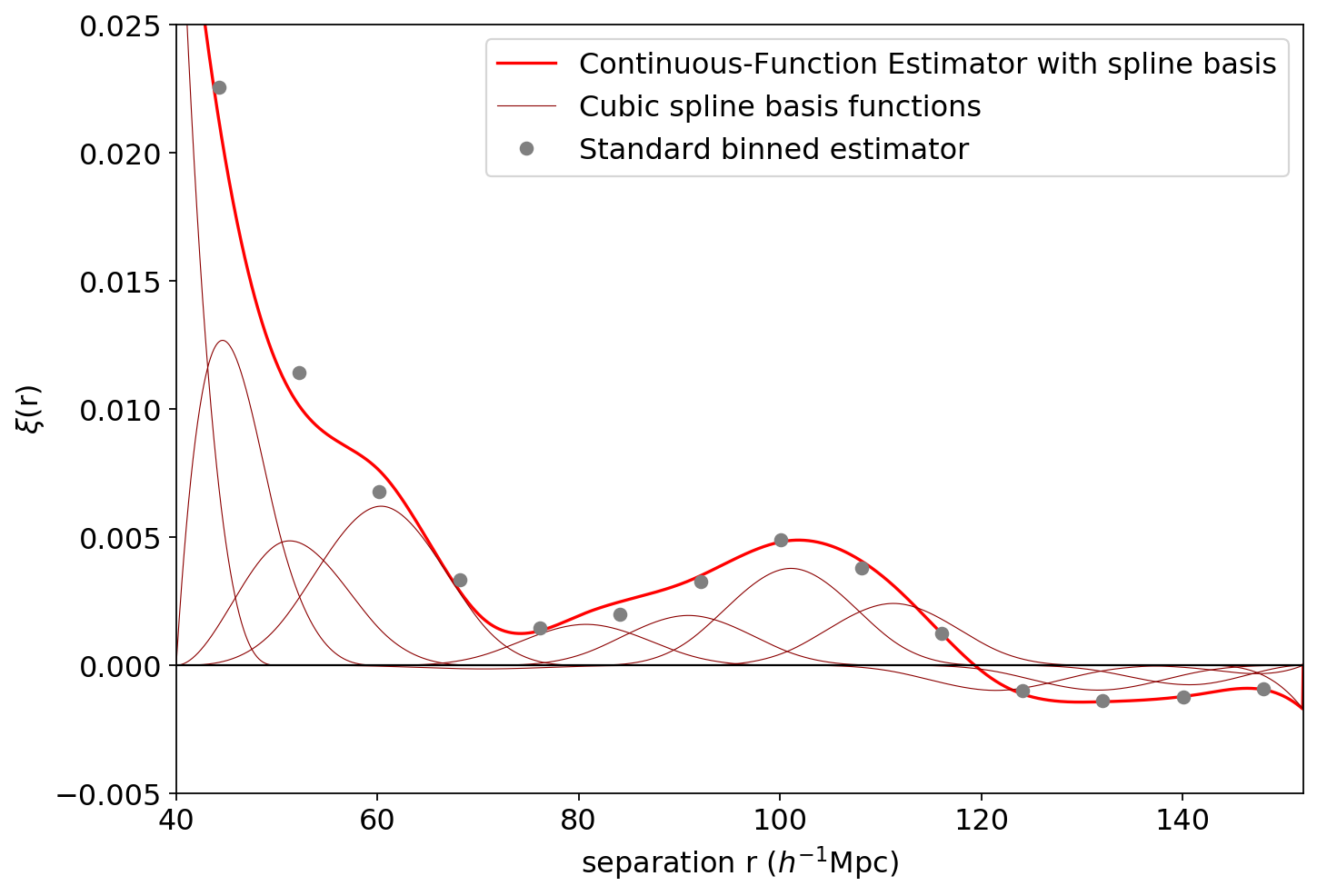Suave basic usage¶
Here we demonstrate the basic usage of the estimator by computing a continuous correlation function using a spline basis. Note that though the package name is suave, we run it with Corrfunc.
Load in a data catalog (in a periodic cube) and generate a random catalog. Note that we are making our random 3x the size of the data so we can compute this in a reasonable amount of time, but in reality you’d want a larger factor.
[1]:
import numpy as np
from Corrfunc import bases, theory, utils, io
boxsize = 750.0
x, y, z = io.read_lognormal_catalog(n='2e-4')
nd = len(x)
nr = 3*nd
np.random.seed(42)
x_rand = np.random.uniform(0, boxsize, nr)
y_rand = np.random.uniform(0, boxsize, nr)
z_rand = np.random.uniform(0, boxsize, nr)
To use the spline basis, set proj_type = general_r, which is the general mode for reading an r-dependent basis from a file. Then use the spline_bases helper function to write the bases to a file:
[2]:
proj_type = 'generalr'
kwargs = {'order': 3}
projfn = 'cubic_spline.dat'
rmin, rmax, ncomponents = 40.0, 152.0, 14
bases = bases.spline_bases(rmin, rmax, projfn, ncomponents, ncont=2000, **kwargs)
To compute the full 3D correlation function, we can use the 2D correlation function DD(s, \(\mu\)) with a single all-encompassing \(\mu\) bin. We use the DDsmu routine to compute the projection vectors v_DD, v_DR, and v_RR, and the projection tensor T_RR. Note that the DR and RR terms take a while to compute (order ~minutes for this notebook); we hope to speed these all up in an upcoming version of suave.
[3]:
r_edges = np.linspace(rmin, rmax, ncomponents+1)
nmubins = 1
mumax = 1.0
periodic = True
nthreads = 2
dd_res, dd_proj, _ = theory.DDsmu(1, nthreads, r_edges, mumax, nmubins, x, y, z,
boxsize=boxsize, periodic=periodic, proj_type=proj_type,
ncomponents=ncomponents, projfn=projfn)
dr_res, dr_proj, _ = theory.DDsmu(0, nthreads, r_edges, mumax, nmubins, x, y, z,
X2=x_rand, Y2=y_rand, Z2=z_rand,
boxsize=boxsize, periodic=periodic, proj_type=proj_type,
ncomponents=ncomponents, projfn=projfn)
rr_res, rr_proj, trr_proj = theory.DDsmu(1, nthreads, r_edges, mumax, nmubins,
x_rand, y_rand, z_rand, boxsize=boxsize,
periodic=periodic, proj_type=proj_type,
ncomponents=ncomponents, projfn=projfn)
From the projection vectors, we can compute the amplitudes with compute_amps, which uses a generalization of Landy-Szalay. We can then evaluate the correlation function on a fine r-grid with evaluate_xi:
[4]:
amps = utils.compute_amps(ncomponents, nd, nd, nr, nr, dd_proj, dr_proj, dr_proj, rr_proj, trr_proj)
r_fine = np.linspace(rmin, rmax, 2000)
xi_proj = utils.evaluate_xi(amps, r_fine, proj_type, projfn=projfn)
Let’s plot the results, comparing to the standard binned estimator (grey dots). We can see that the spline basis produced a smooth, continuous correlation function (thick red line) that is a linear combination of the basis functions (thin dark red lines).
[6]:
from matplotlib import pyplot as plt
xi_res = theory.xi(boxsize, nthreads, r_edges, x, y, z, output_ravg=True)
r_avg, xi_standard = xi_res['ravg'], xi_res['xi']
plt.figure(figsize=(10,7))
plt.plot(r_fine, xi_proj, color='red', lw=1.5, label='Continuous-Function Estimator with spline basis')
r = bases[:,0]
base_vals = bases[:,1:]
for i in range(base_vals.shape[1]):
label = None
if i==0:
label = 'Cubic spline basis functions'
plt.plot(r, amps[i]*base_vals[:,i], color='darkred', lw=0.5, label=label)
plt.plot(r_avg, xi_standard, marker='o', ls='None', color='grey', label='Standard binned estimator')
plt.axhline(0.0, color='k', lw=1)
plt.xlim(min(r), max(r))
plt.ylim(-0.005, 0.025)
plt.xlabel(r'separation r ($h^{-1}$Mpc)')
plt.ylabel(r'$\xi$(r)')
plt.legend()
plt.savefig('spline_example.png')

Finally, remember to clean up the basis function file:
[8]:
import os
os.remove(projfn)